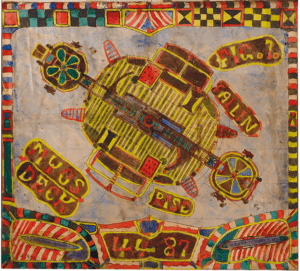At the time of his death in Houston, Texas in 1923, Charles Dellschau was nothing more than an unknown (and indeed unremarkable) retired butcher. Yet a century later, his drawings of brightly-coloured (if somewhat implausible-looking) airships are feted as Art Brut and exhibited widely: while researchers continue to rummage through his books of recollections to try to work out how true (or, conversely, how imaginary / fantastical) his accounts of what happened actually are.
Some people even believe not only that Dellschau’s group of (alleged) Californian inventors flew dirigibles (steerable airships) before 1860, but also that this (somehow) proves that a steampunk super-science cadre was living in our midst; and from there spinning off into all manner of alt.history craziness.
To be fair, it does seem entirely plausible that Dellschau was living in / near Sonora or Columbia in California in 1857-1859, and perhaps at the start of 1860 too. For instance, he’s clearly familiar with nearby places (e.g. Knights Ferry), and later parts of his story do line up satisfactorily with actual evidence.
But for all that, 1857-1859 remains a yawning gap in his CV/résumé. And the fact that there is no evidence linking him to Columbia or Sonora in those years is certainly annoying. So… what’s going on here, then?
Columbia, California
Prior to the Gold Rush, Columbia was barely on the Californian map: but with the rapid hyper-scaling that followed the discovery of gold in 1848, the town quickly had its own shops, bars and hookers, and even its own printing press. It grew so fast that the town was even seriously proposed as a new California state capital to replace Sacramento.
But if you fast forward to 1860, Columbia was a bust: it all panned out, you might say. The last hurrah was a rumour that there were copper deposits beneath the town itself, which triggered frantic digging, rendering many of the buildings unsafe. And then, finally, the few remaining miners there decamped to other nearby towns, such as Copperopolis (though the astute ones had gone long before).
And so we already have a direct answer as to why the archives have no concerted trace of Dellschau and his airship-designing drinking buddies. This was because the 1850 and 1860 dates of the US Census stood rigidly either side of Columbia’s all too brief flourishing – its success was a proverbial flash in the pan. By 1860, pretty much everyone had moved on (including Dellschau himself), leaving the town a (literally) hollowed-out shell of its former thriving self.
Once again, absence of evidence is not evidence of absence.
The Special AKA
In my head, the soundtrack to all this is – perhaps inevitably? – the major chord middle 8 in The Specials’ “Ghost Town”.
“Do you remember the good old days before the ghost town?
We danced and sang, and the music played inna da boomtown“
For me, this brief snatch of the lyrics captures Dellschau’s drawings best: specifically, his burning, shining nostalgia for whatever happened in those three brief years in California, “inna da boomtown“. To my eyes, his bright, almost DayGlo images speak of a past full of possibilities, of a shared peak experience, of everyone at their best, but all reconstructed and captured in far greyer days half a century later.
And then, as the old joke goes, “Tea break’s over, back on your heads“. 😮
Scooby Doo
As you may possibly remember, the theme of abandoned gold rush mining towns appeared in the “Miner 49er” Scooby Doo episode “Mine Your Own Business” [S01 E4] (spoiler: the Monster of the Week was Hank the caretaker, on stilts):
Strictly speaking, Columbia never became a Californian ghost town (unlike, say, Agua Fria in Mariposa County): it stumbled along until 1934, when New Deal archaeologists went in to make sense of the mess: in 1945, the town was restored and turned into the core of Columbia State Historic Park.
The questions everyone ends up asking about Dellschau’s notebooks are very often to do with what his motivation was for writing them. Was it all an act of scientific journalism (of real airships), or an act of pure personal creative expression?
All the same, maybe Dellschau saw himself as a kind of caretaker, trying to keep the memories of his boomtown days alive, even if everyone else involved was now far away or long dead: and where it is highly doubtful whether the airships he was documenting were ever constructed, let alone flown.
For me, I can’t help but wonder whether the 1896-1897 Airship Flap was the thing that first triggered Dellschau into writing down his recollections and reconstructing the designs proposed by his drinking club friends back in 1857-1859. Might his actual motivation have been to instead prove that they (rather than these gosh-darn Airship Flap pretenders) were the real inventors of the idea of the airship?
Ultimately, I guess that makes me Fred Jones removing the monster’s mask to reveal Dellschau as an obsessed caretaker not of a lost history of built airships, but of a lost history of conceptual airship inventors. That is to say, I suspect the ‘gold’ Dellschau was trying to attain was a place in airship history for his inventive friends, from his younger boomtown days when everything – briefly – seemed possible.
“And I’d have got away with it too, if it weren’t (etc)“.

An enjoyable post Nick!
re exhibitions: for mine, I’d contextualise drawings from Dellschau’s writings with examples of signwriters’ work from the mid-late nineteenth century – ideally from his part of America. (or has this been done?)
To get the general idea, imagine a store-front window painted with the same borders and lettering-style, but in the centre replace that airship with a cow-carcass. A persons speaks the dialect he’s used to, in art as in writing.
For others of his drawings, add a dash of Riou and there you are.
PS. that’s Édouard Riou, illustrator for six of Jules Verne’s novels.